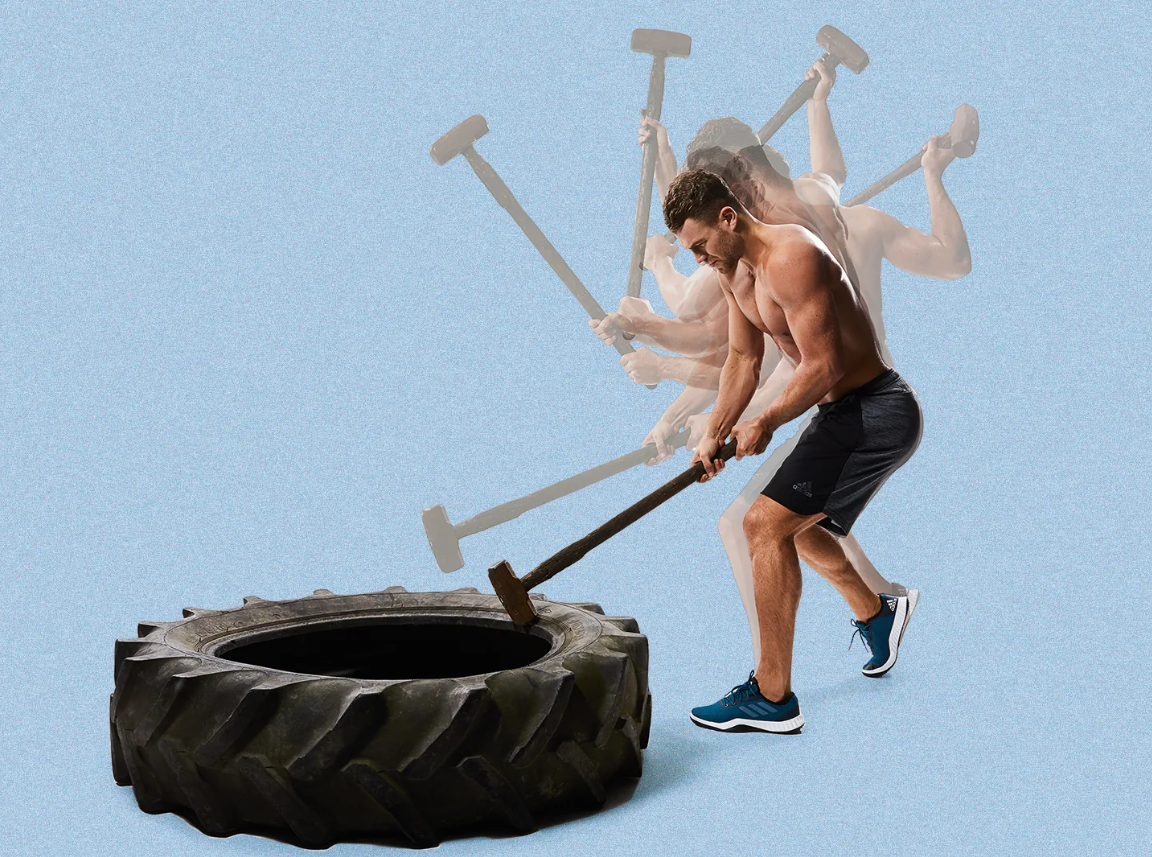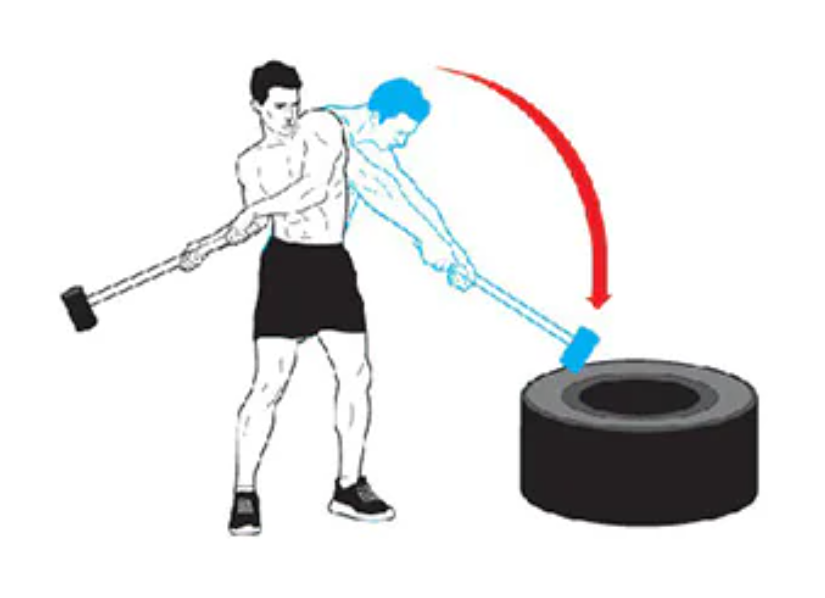Yes, swinging a hammer is an excellent workout. It engages multiple muscle groups, burns calories, and offers cardiovascular benefits. Swinging a hammer, often referred to as sledgehammer training, has gained popularity as an effective full-body workout. This unconventional exercise engages multiple muscle groups, burns calories, improves cardiovascular health, and offers numerous other fitness benefits.
In this comprehensive article, we will explore the benefits of swinging a hammer, techniques for safe and effective hammer swinging, fitness routines incorporating hammer swinging, comparisons with other workout tools, expert opinions and user experiences, and frequently asked questions about hammer swinging workouts.
Benefits of Swinging a Hammer as a Workout
Muscle Groups Engaged
Swinging a hammer is a dynamic exercise that targets several major muscle groups. The primary muscles engaged include:
Core Muscles
The core muscles, including the abdominals, obliques, and lower back, play a crucial role in stabilising the body during the swinging motion. The twisting and bending involved in the swing engage these muscles intensely.
Upper Body Muscles
The shoulders, arms (biceps and triceps), and chest are heavily involved in generating the power needed to swing the hammer. The repetitive motion helps in building strength and endurance in these muscle groups.
Lower Body Muscles
The legs, including the quadriceps, hamstrings, and glutes, provide the foundation for a stable stance and help generate power from the ground up.
Calorie Burning Potential
Swinging a hammer is an excellent calorie-burning exercise. The high-intensity, full-body movement requires significant energy expenditure. Depending on the intensity and duration of the workout, individuals can burn between 300 to 500 calories per half-hour session. This makes it an effective exercise for weight loss and improving overall fitness.
Cardiovascular Benefits
The continuous and vigorous nature of hammer swinging elevates the heart rate, providing a robust cardiovascular workout. Regular hammer swinging sessions can improve cardiovascular endurance, enhance blood circulation, and reduce the risk of heart disease. The combination of aerobic and anaerobic exercise in hammer swinging offers comprehensive cardiovascular benefits.
Techniques for Safe and Effective Hammer Swinging
Proper Grip and Stance
Ensuring a proper grip and stance is fundamental to safely and effectively swinging a hammer:
- Grip: Hold the handle firmly with both hands. For a two-handed grip, place one hand near the end of the handle and the other hand a comfortable distance up the handle. Adjust the grip according to the task and personal comfort.
- Stance: Stand with feet shoulder-width apart for balance. Bend the knees slightly and keep the back straight to engage the core muscles. This stance provides stability and helps generate power from the lower body.
Warm-Up Exercises
Warming up is essential to prepare the body for the intense physical activity involved in hammer swinging. Effective warm-up exercises include:
- Dynamic Stretching: Perform dynamic stretches such as arm circles, leg swings, and torso twists to increase blood flow to the muscles.
- Light Cardio: Engage in light cardiovascular activities like jogging or jumping jacks to elevate the heart rate and prepare the body for the workout.
Avoiding Common Injuries
To minimise the risk of injuries, follow these safety tips:
- Start with Light Weight: Beginners should start with a lighter hammer to master the technique before progressing to heavier weights.
- Maintain Proper Form: Focus on maintaining proper form throughout the exercise to avoid unnecessary strain on the joints and muscles.
- Listen to Your Body: Pay attention to any signs of discomfort or pain. Stop the exercise immediately if you experience any sharp pain or discomfort.
Fitness Routines Incorporating Hammer Swinging
Hammer Workout Variations
There are several variations of hammer swinging exercises that can be incorporated into fitness routines:
Basic Hammer Swing
This involves swinging the hammer from a high position to a low position, targeting the core, shoulders, and arms.
Side-to-Side Swing
Swing the hammer from one side of the body to the other, engaging the obliques and improving rotational strength.
Overhead Slam
Raise the hammer overhead and slam it down forcefully, engaging the entire upper body and core.
Integration with Other Exercises
Hammer swinging can be integrated with other exercises to create a comprehensive workout routine:
Circuit Training
Combine hammer swings with other bodyweight exercises like push-ups, squats, and burpees for a high-intensity circuit training session.
Interval Training
Alternate between hammer swings and short bursts of cardio exercises like sprints or jumping jacks to create an effective interval training routine.
Progression and Challenges
To continue progressing and challenging the body, consider the following tips:
- Increase Weight: Gradually increase the weight of the hammer as you build strength and improve technique.
- Vary Movements: Incorporate different hammer swinging variations to target different muscle groups and prevent workout monotony.
- Increase Intensity: Increase the intensity of the workout by reducing rest periods between sets or adding more repetitions.
Comparison with Other Workout Tools
Swinging Hammer vs. Kettlebell
When it comes to functional fitness, both the sledgehammer and the kettlebell are popular tools that offer unique benefits. Swinging a hammer involves dynamic, full-body movements that enhance strength, power, and coordination, mimicking real-world tasks such as chopping wood or breaking objects. This exercise targets a variety of muscle groups, including the core, shoulders, arms, and legs, providing a comprehensive workout.
On the other hand, kettlebell training is renowned for its versatility and efficiency. Kettlebell exercises, such as swings, snatches, and cleans, focus on building explosive power, endurance, and functional strength. The compact design of kettlebells allows for a wide range of movements that can be easily integrated into various workout routines, making them a favourite among fitness enthusiasts for both strength training and cardiovascular conditioning.
- Muscle Engagement: Both sledgehammers and kettlebells engage multiple muscle groups. However, sledgehammer swings primarily target the upper body and core, while kettlebell exercises often engage the lower body as well.
- Cardio Benefits: Kettlebell workouts tend to have a more pronounced cardiovascular component due to the continuous motion and higher repetitions.
- Versatility: Kettlebells offer a wider range of exercises, but sledgehammer swings provide a unique and intense workout that complements other forms of training.
Swinging Hammer vs. Dumbbell
Swinging a hammer and using dumbbells offer distinct fitness benefits. Hammer swings engage multiple muscle groups through dynamic, functional movements, enhancing overall strength, coordination, and cardiovascular fitness. They particularly target the core and upper body, offering a robust cardio workout and significant calorie burn.
In contrast, dumbbells allow for a variety of exercises targeting almost every muscle group with controlled movements that improve muscle symmetry and balance. Combining both in a fitness routine can provide a comprehensive workout, leveraging the unique advantages of each tool.
- Dynamic Movement: Sledgehammer swings involve more dynamic and explosive movements compared to traditional dumbbell exercises, which often focus on controlled, isolated movements.
- Functional Strength: Swinging a sledgehammer builds functional strength, mimicking real-world movements and enhancing overall athleticism.
- Equipment Requirements: Dumbbells are more versatile and can be used for a variety of exercises, but sledgehammer workouts require minimal equipment and space.
Expert Opinions and User Experiences
Fitness Professionals' Insights
Fitness experts recognize the benefits of sledgehammer workouts for building strength, improving cardiovascular fitness, and enhancing overall athletic performance. According to fitness professionals, the dynamic nature of hammer swinging helps in developing functional strength, improving coordination, and providing an intense calorie-burning workout.
Real life success stories
Many individuals who have incorporated sledgehammer workouts into their fitness routines report significant improvements in strength, endurance, and overall fitness. Testimonials highlight the effectiveness of hammer swinging in targeting multiple muscle groups, increasing heart rate, and providing a challenging and rewarding workout experience.
John’s Journey to Weight Loss and Strength Gains
John, a 35-year-old office worker, struggled with weight gain and a sedentary lifestyle. John incorporated sledgehammer workouts into his routine, starting with three sessions per week and gradually increasing intensity and duration. He combined these with bodyweight exercises like push-ups and squats.
He Improved strength and endurance within the first month And Lost 15 pounds by the third month. John achieved substantial weight loss and strength gains, transforming his health and fitness through consistent sledgehammer workouts.
Sarah’s Enhanced Athletic Performance
Sarah, a 28-year-old amateur athlete, aimed to enhance her athletic performance and overall fitness. Sarah integrated sledgehammer exercises into her cross-training routine, complementing them with running, plyometrics, and strength training.
She Noticed significant improvements in strength and explosiveness within two months. Sarah's sledgehammer workouts significantly boosted her athletic performance, making her stronger, more agile, and better prepared for her sports activities.
Several success stories demonstrate the transformative effects of sledgehammer workouts. Individuals who have consistently engaged in hammer swinging exercises have reported improved athletic performance, weight loss, and enhanced physical conditioning. These success stories emphasize the importance of proper technique, consistency, and progression in achieving fitness goals.
Frequently Asked Questions About Hammer Swinging Workout
Q. What are hammer swings?
- Hammer swings are a type of exercise that involves swinging a heavy hammer, typically a sledgehammer, in a controlled manner to build strength, endurance, and coordination. This movement mimics the action of chopping or breaking objects, engaging multiple muscle groups throughout the body. Hammer swings are commonly used in functional training and can be performed as part of a workout routine to improve overall fitness and cardiovascular health.
Q. How do you swing a hammer?
- To swing a hammer properly:
- Grip: Hold the handle with both hands, one near the end and the other higher up for control.
- Stance: Stand with your feet shoulder-width apart, knees slightly bent, and core engaged.
- Motion: Lift the hammer overhead or to the side, then bring it down forcefully towards a target, such as a tire or mat.
- Follow-Through: Allow your hips and shoulders to rotate naturally, maintaining control and balance.
- Return: Bring the hammer back to the starting position and repeat.
Q. Does swinging a hammer build muscle?
- Yes, swinging a hammer can build muscle. The exercise engages several major muscle groups, including:
- Core muscles: Abs, obliques, and lower back.
- Upper body muscles: Shoulders, biceps, triceps, and chest.
- Lower body muscles: Legs and glutes, which provide stability and power during the swing.
The repetitive, full-body movement promotes muscle growth and strength development through resistance training.
Q. What does hitting the hammer mean?
- In the context of fitness, "hitting the hammer" often refers to the act of striking a target, such as a tire or padded surface, with a sledgehammer. This exercise is used to simulate the functional movement of swinging a hammer in activities like construction or demolition. It helps improve power, coordination, and cardiovascular fitness while also providing a high-intensity workout that engages multiple muscle groups.
Q. How Often Should One Swing a Hammer?
- The frequency of hammer swinging workouts depends on individual fitness levels and goals. Beginners may start with two to three sessions per week, allowing adequate rest between workouts. As fitness levels improve, individuals can increase the frequency to four to five sessions per week.
Q. Can Anyone Do a Hammer Workout?
A. Hammer swinging workouts can be adapted to suit various fitness levels. Beginners should start with lighter hammers and focus on mastering proper technique. Individuals with pre-existing medical conditions or injuries should consult with a healthcare professional before starting a hammer workout routine.
Q. Are the Risks Involved?
- While hammer swinging is an effective workout, it carries certain risks, including:
- Muscle Strain: Overexertion or improper form can lead to muscle strains or injuries.
- Joint Stress: The repetitive and dynamic nature of hammer swinging can put stress on the joints, particularly the shoulders, elbows, and wrists.
- Impact Injuries: Accidental impacts with the hammer or striking surface can cause injuries. Using proper safety gear and maintaining focus during the exercise can help minimize these risks.
In conclusion, swinging a hammer as a workout offers numerous benefits, including engaging multiple muscle groups, burning calories, and improving cardiovascular fitness. By following proper techniques, incorporating hammer swinging into fitness routines, and taking necessary safety precautions, individuals can achieve significant improvements in strength, endurance, and overall fitness. Expert opinions, user experiences, and success stories further validate the effectiveness of hammer swinging workouts. Whether as a standalone exercise or integrated with other training methods, hammer swinging provides a unique and challenging workout that can help individuals reach their fitness goals.










